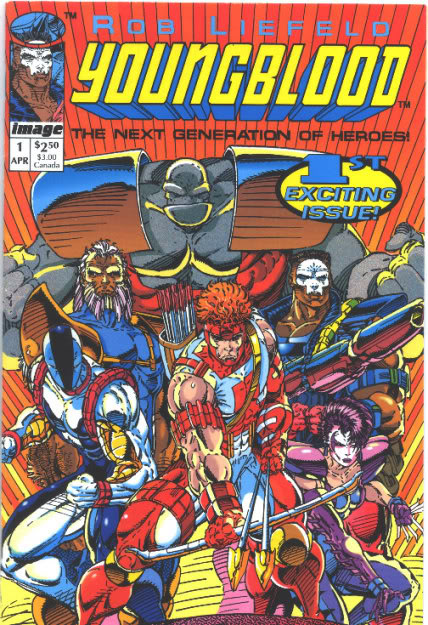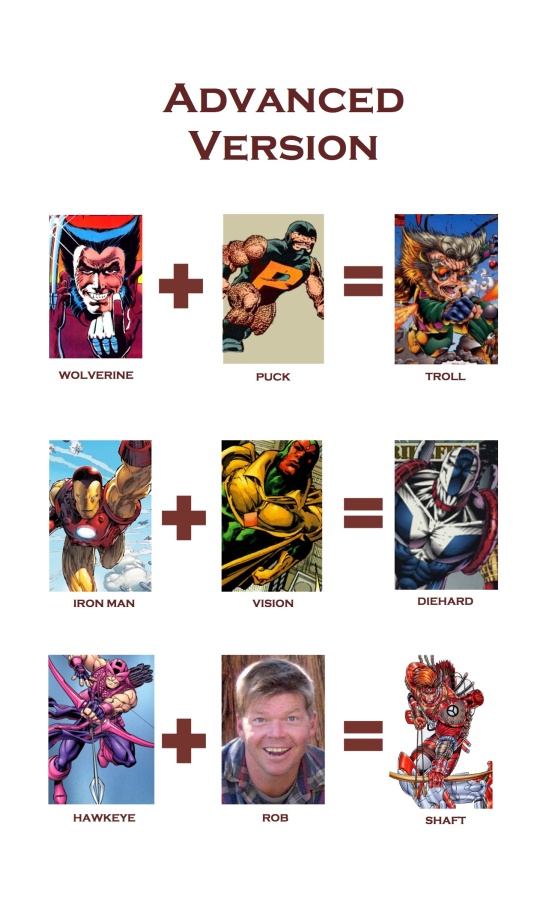
This post is a response to one written by The Dakoit over at Comic Book Speculation for Fun. Dakoit suggests that Youngblood #1 is actually a collector’s item. It’s a counter-intuitive argument, because everyone has a copy of Youngblood #1 and nobody wants a copy of Youngblood #1. Still, I’m mostly persuaded.
First, a brief history of Youngblood. They’re a superhero team, the brainchild of controversial 90s phenom Rob Liefeld, Youngblood was meant to be Image’s answer to the Avengers. It was, like most Liefeld creations, a brazen rip-off of well-established Marvel and DC characters. For instance:


The case against Youngblood #1:
The comic cannot stand on its own. As Mark Ginocchio recently argued over at Comic Book Resources, the story is garbage. And the art, well it’s Liefeld. And while Liefeld is consistently able to get work in the industry, to say his art is “polarizing” would be generous. Many readers detest him. If you’re in the mood for a good laugh, Bill Hanstock and Brandon Stroud pretty much dropped the microphone after soundly demolishing Liefeld’s style back in 2007.
And Youngblood is Liefeld’s signature creation, so it exhibits all of his creative vices, especially 1-dimensional, copycat characters that no one cares about. No one is trying to track down the first appearance of Vogue or Diehard.
The case against Youngblood #1 is basically that nobody who’s anybody takes Liefeld’s work seriously, and that while the characters themselves persist (20 years later!), they still don’t rate. They’re not significant characters.
So, why would anyone want this book?
The case for Youngblood #1:
The Dakoit’s central claim is that the comic is historically significant. It is the first comic published by Image Comics, and Image has gone on to become the third largest company in the industry. It’s produced several characters who have attracted, at one time or another, devoted fan bases (i.e. Spawn, Witchblade, Invincible). Image has also become the “hot” publisher of late. Books like Saga and The Walking Dead have become fan favourites, and early issues demand high resale prices.
I buy this. Maybe not today, maybe not tomorrow, but before too long, the first comic ever published by Image will be considered historically significant.
Here’s another important consideration: Deadpool’s first appearance is in New Mutants #98, another Rob Liefeld joint. That comic easily fetches $100 a pop on eBay, often more. And news of the X-Force movie is probably about to send its value through the stratosphere. Liefeld or no Liefeld that comic has value.
It’s also worth noting that even though Liefeld has more than his share of detractors, he manages to continue working. What he lacks in artistic talent he seems to make up for in industry connections and professional know-how. People keep hiring Liefeld; he has to be doing something right. Would it surprise you if the guy was somehow able to get a Youngblood movie to happen? This is wild speculation, obviously, but if the public appetite for superhero movies continues, studios are going to look beyond Marvel and DC for the next Avengers. And if you were looking to make a copycat of the Avengers? What better source material than the comic that copycats the Avengers?
One last thing, insofar as Youngblood #1 signifies all things Liefeldian it stands as a monument to a particular era in comics history. The 90s produced certain excesses. The industry was ultimately damaged. Some people still hate anything to do with the period. But, as any Toronto Blue Jays fan knows, 1992 was a long time ago. It may be time to look at the comics of the era with some fresh eyes. If we do that, I think we start to see that Youngblood #1 has some value.



